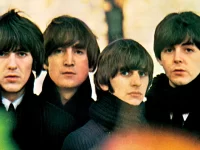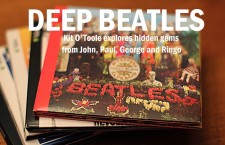One of Paul McCartney’s earliest compositions, “I’ll Follow the Sun” dates from 1959 but finally found a home five years later on 1964’s Beatles for Sale. It’s a prime example of how a song develops over time and changes radically from its earliest incarnation. In addition, like the rest of Beatles for Sale, it symbolizes the transition from the “early Beatles” sound to the folk-rock experiments of Rubber Soul.
McCartney told author Mark Lewisohn that he remembered first writing “I’ll Follow the Sun” at his family’s home on Forthlin Road in Liverpool. He remembered being a 16-year-old budding musician and songwriter, “standing in the parlor, with my guitar, looking out through the lace curtains of the window, and writing that one. We had this hard R&B image in Liverpool, so I think songs like ‘I’ll Follow The Sun,’ ballads like that, got pushed back to later.” While McCartney recalled Lennon assisting him with the composition, Lennon refuted that in a 1980 interview. “That’s Paul again. Can’t you tell? I mean: ‘Tomorrow may rain so — I’ll follow the sun.’ That’s another early McCartney, you know … written almost before the Beatles, I think. He had a lot of stuff.”
Featuring a sound reminiscent of Buddy Holly and Carl Perkins, an early version was recorded in Paul McCartney’s bathroom circa April 1960. McCartney, Lennon, George Harrison and then-bassist Stuart Sutcliffe laid down “I’ll Follow the Sun” as well as several other tracks on a crude tape recorder (borrowed from neighbor Charles Hodgson), including an early version of “One After 909”; another Lennon/McCartney composition, “Hello Little Girl”; and covers of songs such as “Matchbox” and “Hallelujah, I Love Her So.”
The tapes circulated among bootleg collectors in the 1980s, but in 1995 Hodgson’s grandson Peter found the original recorder and tape forgotten in the family home’s attic in Liverpool. He subsequently sold the tape to McCartney in 1995, and a few songs from the session surfaced on the Anthology 1 compilation. Mysteries remain as to the exact time period of the recordings (some dispute McCartney’s account), how many copies exist, and even the precise personnel; for example, McCartney claims that younger brother Michael played some type of percussion.
Regardless of the tape’s background, it provides a fascinating glimpse into the early Beatles as well as their composing process. The 1960 version of “I’ll Follow the Sun” boasts a faster tempo, a different guitar solo, and altered lyrics. Although difficult to decipher due to the poor sound quality, an example of original lyrics includes McCartney singing what sounds like the following: “Well don’t leave me alone, my dear; I’ll hurry, and call on me my sweet.” The 1964 version would be revised to read “And now the time has come — and so my love, I must go.”
By August 11, 1964, the Beatles found themselves back in Abbey Road Studio Two, beginning the hurried sessions that would eventually produce Beatles for Sale. Having released A Hard Day’s Night in the U.K. just a month before, the group scrambled to fulfill their “two albums a year” contract; after all, the holidays demanded a new Beatles product. Thus, John Lennon and Paul McCartney reached into their archives to find enough material to fill an album.
The Beatles laid down eight takes on October 18, the final take being the only one to contain George Harrison’s electric guitar break rather than an acoustic one. McCartney played bass and acoustic guitar and sang lead vocals; Lennon contributed acoustic rhythm guitar and harmony vocals; Harrison played lead guitar; and Ringo Starr assumed percussive duties.
“I’ll Follow the Sun” demanded a different type of drumming style, however. As McCartney told Barry Miles in the biography Many Years from Now, “on the record we got Ringo to tap his knees. … We didn’t want to fall into the Supremes trap where [their singles] all sounded rather similar, so to that end, we were always keen on having varied instrumentation.” He further explained Starr’s unique performance on the track: “Ringo couldn’t keep changing his drum kit, but he could change his snare, tap a cardboard box or slap his knees.” The unusual percussion also recalls an early influence on the group: Buddy Holly, specifically the track “Everyday.”
Little other footage existed of this session until July 2008, when a newly discovered reel-to-reel tape went on the auction block. The footage includes takes of “I’ll Follow the Sun,” as well as “I’m A Loser,” “Honey Don’t,” “Everybody’s Trying to Be My Baby,” “She’s A Woman,” “Too Much Monkey Business,” “Something’s Gotta Hold of Me,” “Nitty Gritty,” and “I Shall Not Be Moved.” The historic tape ultimately sold for £9,800.
Shortly after completing the sessions, the Beatles recorded a live version of “I’ll Follow the Sun” for the BBC program Top Gear. Taped on November 17, the performance aired on November 26, 1964. Their delicate version — quite faithful to the studio recording — remained unheard (except among bootleg collectors) until 1995, when it was included on the 1995 “Baby It’s You” CD and vinyl singles. It later appeared on the 2013 On Air: Live at the BBC Volume 2 compilation.
“I’ll Follow the Sun” not only stands as a melancholy ballad; it prefigures the acoustic folk-rock sound the Beatles would explore on Help! and more fully on Rubber Soul. It also exemplifies Paul McCartney’s composition style: simple arrangements, prominent melodies, and introspective lyrics.
As he has mentioned in interviews, early Lennon/McCartney compositions typically used the second person to communicate with listeners. Here, McCartney is more internal, revealing only his perspective in an apparently dying relationship. “One day you’ll look to see I’ve gone,” he tells his lover. However, he hints that life will go on, that change will be welcome: “tomorrow may rain, so I’ll follow the sun.”
As the first of two bridges occur, McCartney and Lennon harmonize to emphasize the relationship’s inevitable end: “And so the time has come — and so my love, I must go,” they sing wistfully. Then comes two intriguing lines: “And though I lose a friend, in the end you will know.” In other words, the narrator recognizes the pain of ending a romance, but feels the woman will eventually understand his decision. The lyrics are vague enough that the listener can assign different interpretations as to their meaning, perhaps an intentional strategy.
The song’s instrumentation predicts the dominant sound of Rubber Soul: acoustic guitars and gentle percussion. George Harrison performs a very brief slide guitar solo, but Lennon and McCartney’s acoustic guitar picking carry the tune. Ringo Starr’s knee-slapping percussion provides the perfect backdrop for this delicate tale of a fractured romance.
Beatles for Sale can be seen as a bridge between the early Beatles and the emerging “new” Beatles, a group that would explore different genres and expand the boundaries of rock. Although one of Paul McCartney’s first compositions, “I’ll Follow the Sun” can also be viewed as a preview of future masterpieces such as “Yesterday,” “I’m Looking Through You,” “I Will,” “Mother Nature’s Son” and “Blackbird.” All typify McCartney’s knack for writing deceptively simple tunes that contain a memorable melody, sparse arrangement, and introspective lyrics.
“I’ll Follow the Sun” provides a glimpse into McCartney’s future growth as a songwriter, integrating his earliest influences (Holly and Perkins) while establishing his unique composing style. It is telling that Paul McCartney occasionally performs “I’ll Follow the Sun” in concert, as he must consider it an important stepping stone in his artistic development.
- The Rescued Early Paul McCartney Song That Completed ‘Beatles For Sale’ - December 4, 2024
- A Rare Beatles Cover Proves John Lennon Was Wrong About His Voice - November 26, 2024
- How John Lennon Came Roaring Back on the Beatles’ White Album - November 22, 2023




Another nice review, Kit.
Thanks for including the 1960 version. I had never heard that before!
“I’ll Follow the Sun” is a microcosm of what made/makes the Beatles special.
Some artists would consider this a minor piece, a filler on an LP, but the Beatles take great care in making it special:
The harmonies, the short but soulful 8 note solo, and the percussion.
Also were the varied lyrics. Before the line, “Tomorrow may rain” Paul varies “For” “But (3x)” “Yet”. Each one is an important distinction in the vagueness of the meaning.
In lesser hands, this song could be overblown, or stretched to the point of thinness.
It’s also an important song for McCartney. For this album, you can say this was his weakest composition showing in the Beatles catalog.
Including I’ll Follow The Sun, there was only the b-side She’s A Woman, Every Little Thing (sung by John), and What You’re Doing. He also co-wrote Eight Days a Week.
It is a great singalong song too, as Paul’s concert versions have proven.
Agreed, Siegel! What’s interesting is that Geoff Emerick put down George’s solo in his book, which I thought was unwarranted. He shouldn’t have played some elaborate solo during an otherwise delicate song–it would have overwhelmed the whole track!
a well thought out analysis!
Thank you so much!